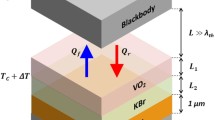Abstract
A new device for the gigahertz modulation of far-infrared radiation is analytically and numerically analyzed. It consists of a thin layer of a high-mobility, direct-bandgap semiconductor, such as GaAs, in which a high-density electron-hole plasma is rapidly created and destroyed, thereby rapidly changing the free-carrier reflectivity of the active layer. Illumination by a high-power, near-infrared laser diode array generates the plasma through intrinsic photoconduction. It is shown that this device acis primarily as an amplitude modulator, and that its efficiency increases sharply with increasing far-IR frequency, in contrast to a Schottky diode, which acts primarily as a phase modulator, and whose efficiency falls off sharply with far-IR frequency. The breakeven frequency lies at about 1.5 THz, depending slightly on the assumed device parameters. The relative advantage of the new device increases rapidly with increasing far-infrared frequency. At an operating frequency of 2.5 THz (119 μm), for example, a 1 GHz modulation bandwidth may be achieved with a single-sideband conversion loss of only-21 db, versus a Schottky's loss of-39 db, assuming a laser diode power of 1 W, which is readily available from recently developed laser diode arrays.
Similar content being viewed by others
References
D.D. Bićanić, B.F.J. Zuidberg, and A. Dymanus, “Generation of Continuously Tunable Laser Sidebands in the Submillimeter Region”,Appl. Phys. Lett.,32 (6), p. 367 (1978).
J. Farhoomand, G.A. Blake, M.A. Frerking, and H.M. Pickett, “Generation of Continuously Tunable Laser Sidebands in the Far-infrared Region”,J. Appl. Phys.,57, p. 1763 (1985)
G. Fiau, F.X. Brown, D. Dangoisse, and P. Glorieux, “Heterodyne Detection of Tunable FIR Sidebands”,IEEE J. Quantum Elec.,QE-23 (8), p. 1388 (1987).
I.S. Park, E.E. Haller, E.N. Grossman, and Dan M. Watson, “Germanium:gallium Photoconductors for Far-infrared Heterodyne Detection”,Appl. Optics,27(19), p. 4143 (1988) and
E.N. Grossman, “A Far-infrared Heterodyne Spectrometer for Airborne Astronomy”,Ph.D. thesis, California Institute of Technology, (1987)
E.N. Grossman, “Performance of Schottky Diodes as Far-infrared Modulators”,Intl. J. of IR and MM Waves,8(10), p. 1293 (1987).
W. Streifer, D.R. Scifres, G.L. Harnagel, D.F. Welch, J. Berger, and M. Sakamoto, “Advances in Diode Laser Pumps”,IEEE J. Quantum Elec.,JQE-24(6), p. 883 (1988) describe an experimental 8 W, 100 μm aperture array.
Y.D. Lin, D.P. Neikirk, and T. Itoh, “Coplaner Waveguide Phase Shifter Controlled by a Spatially Periodic Optical Illumination”,Intl. J. IR and MM Waves,8(9), p. 1027 (1987) and
M. Matsumoto, M. Tsutsugi, and N. Kumigai, “Radiation of Millimeter Waves froma Leaky Dielectric Waveguide with a Light-Induced Grating Layer,”,IEEE Trans. Microwave Theory Tech.,MTT-35(11), p. 1033 (1987).
S.J. Allen, C.L. Allyn, H.M. Fox, F. DeRosa, and G.E. Mahoney, “Dispersion of the Saturated Current in GaAs from DC to 1200 GHz”,Appl. Phys. Lett.,42(1), p. 96 (1983)
J.S. Blakemore, “Semiconducting and Other Major Properties of Gallium Arsenide”,J. Appl. Phys.,53, p. R123 (1982) and references therein
H.R. Chadrasekhar and A.K. Ramdas, “Non-parabolicity of the Conduction Band and Coupled Plasmon-Phonon Modes in n-GaAs”,Phys. Rev. B,B21, p. 1511 (1980)
A.A. Kukharskii, “Plasmon-Phonon Coupling in GaAs”,Solid State Comm.,13, p. 1761 (1973), and “Damping Effects on the Plasmon-Phonon Spectrum of a Solid”,Sov. Phys.-Solid State 14(6) p. 1501 (1972)
M. Born and E. Wolf, “Principles of Optics”, 6th ed., §13.4, Pergamon Press, Oxford (1980)
Spectra-Diode Laboratories SDL-3480 Data Sheet, Nov. 1988, San Jose, CA
S. Sze,Physics of Semiconductor Devices, New York, Wiley, (1981), p. 713 ff, and references therein
Univ. of Virginia, batch 1E12 (R. Mattauch and T. Crowe)
M. Boulou and D. Bois, “Cathodoluminescence Measurements of the Minoritycarrier Lifetime in Semiconductors”,J. Appl. Phys.,48(11), p. 4713 (1977)
R.J. Nelson and R.G. Sobers, “Interfacial Recombination Velocity in GaAlAs/-GaAs Heterostructures”,Appl. Phys. Lett. 32(11), p. 761 (1978)
R.J. Nelson and R.G. Sobers and “Minority-carrier Lifetime and Internal Quantum Efficiency of Surface-free GaAs”,J. Appl. Physics,49(12), p. 6103 (1978)
D.L. Keune et al., “Optical Phase Shift Measurements of Carrier Decay Times on Lightly Doped Double Surface and Surface-free Epitaxial GaAs”,J. Appl. Phys.,42, p. 2048 (1971)
H. Nather and L.G. Quagliano, “Inelastic Light Scattering in Highly Excited GaAs”,J. of Luminescence,30, p. 50 (1985)
C. Klingshern and H. Huag, “Optical Properties of Highly Excited Direct Gap Semiconductors”,Phys. Rep.,70(5), p. 388 (1981) and
S. Tanaka, H. Kobayashi, H. Saito, and S. Shionoya, “Spontaneous Luminescence due to High Density Electron-Hole Plasma in GaAs Under Nano-and Pico-second Pulse Excitation”,Solid State Comm.,33, p. 167 (1980)
D. Bimberg, H. Munzel, A. Steckenborn, and J. Christen, “Kinetics of Relaxation and Recombination on Nonequilibrium Carriers in GaAs: Carrier Capture by Impurities”,Phys. Rev. B,31(12), p. 7788 (1985)
Author information
Authors and Affiliations
Rights and permissions
About this article
Cite this article
Grossman, E.N. Otpically illuminated dielectric interfaces as high-speed far-infrared modulators. Int J Infrared Milli Waves 10, 803–820 (1989). https://doi.org/10.1007/BF01011492
Received:
Issue Date:
DOI: https://doi.org/10.1007/BF01011492



